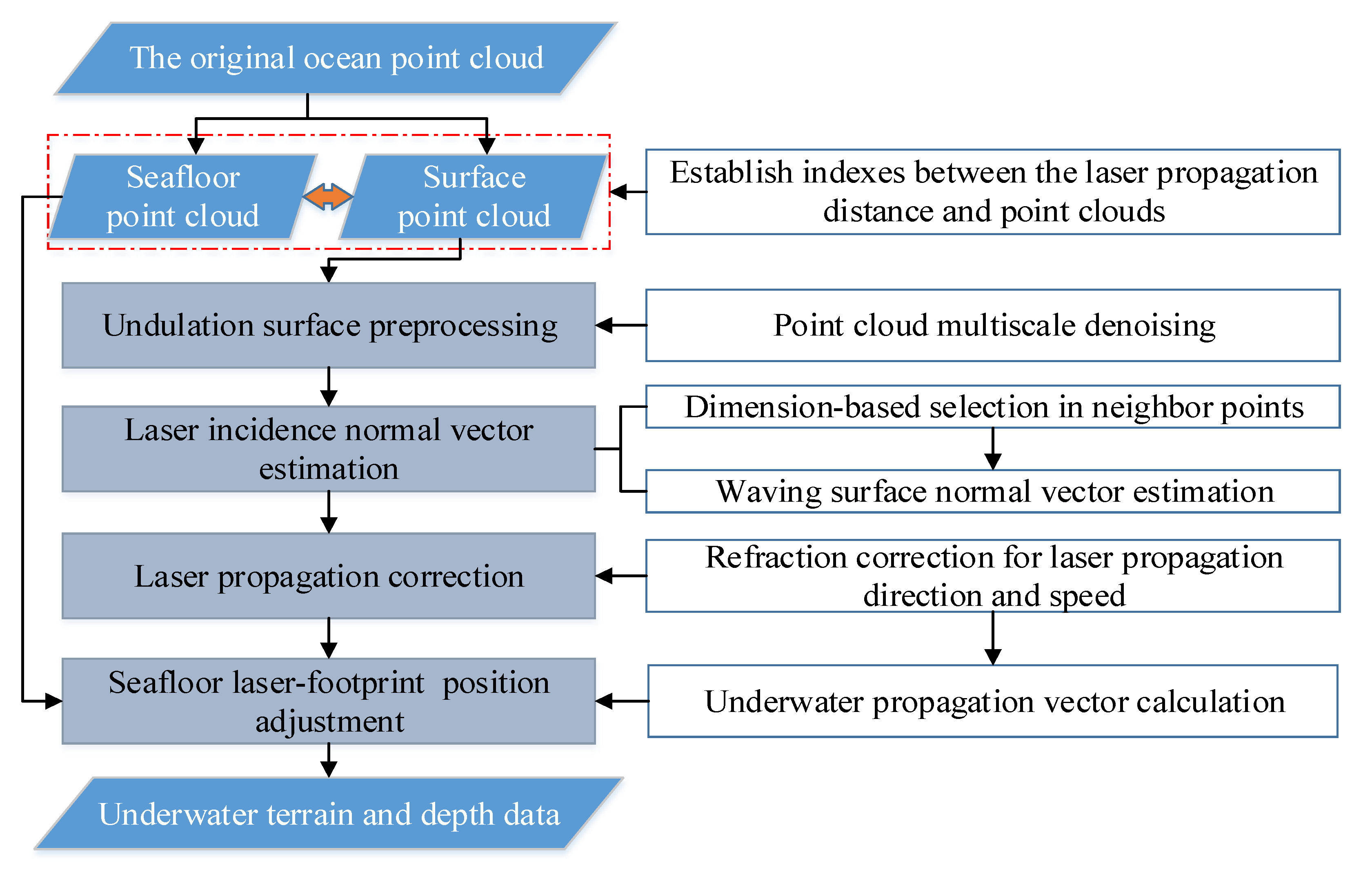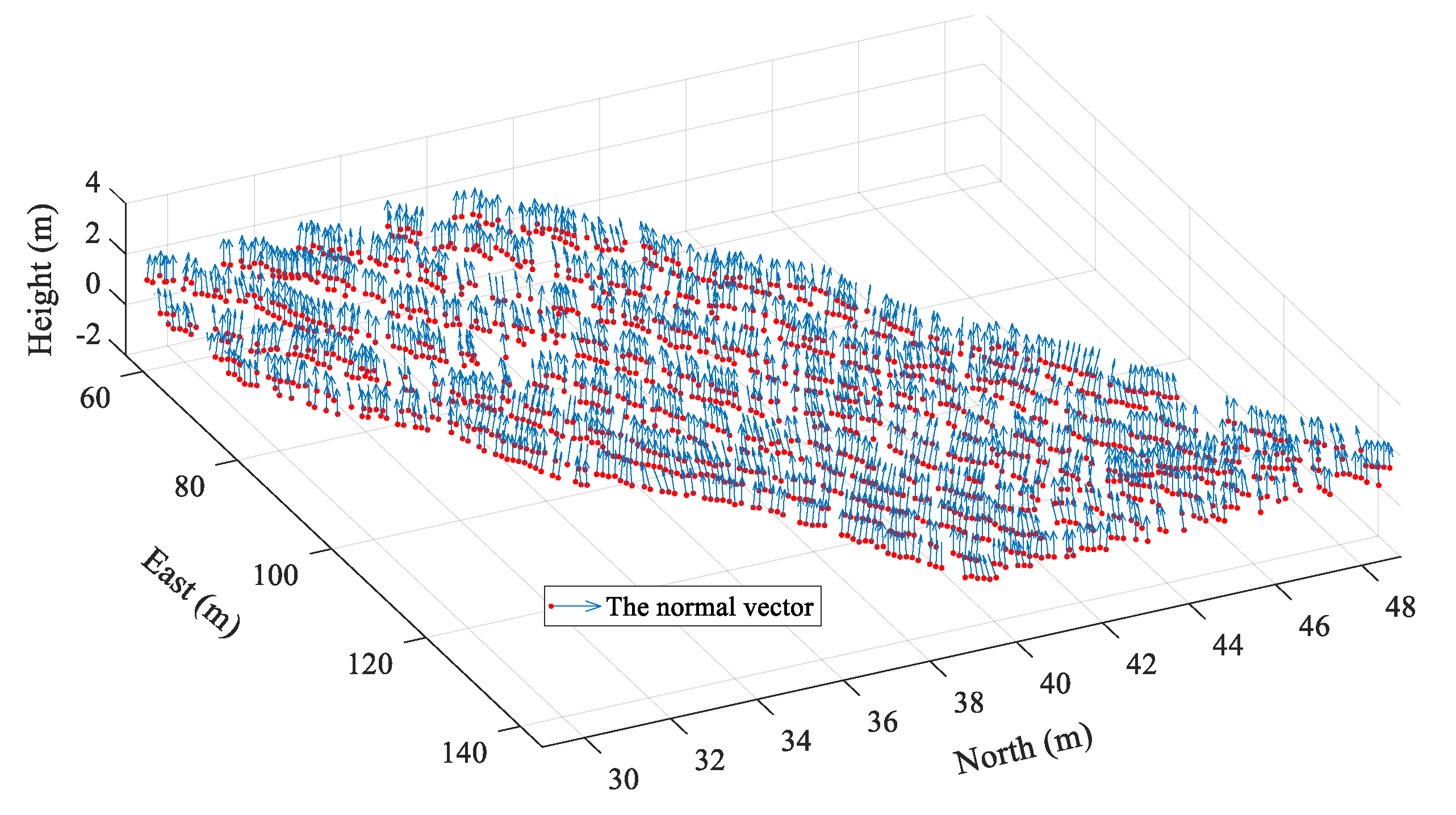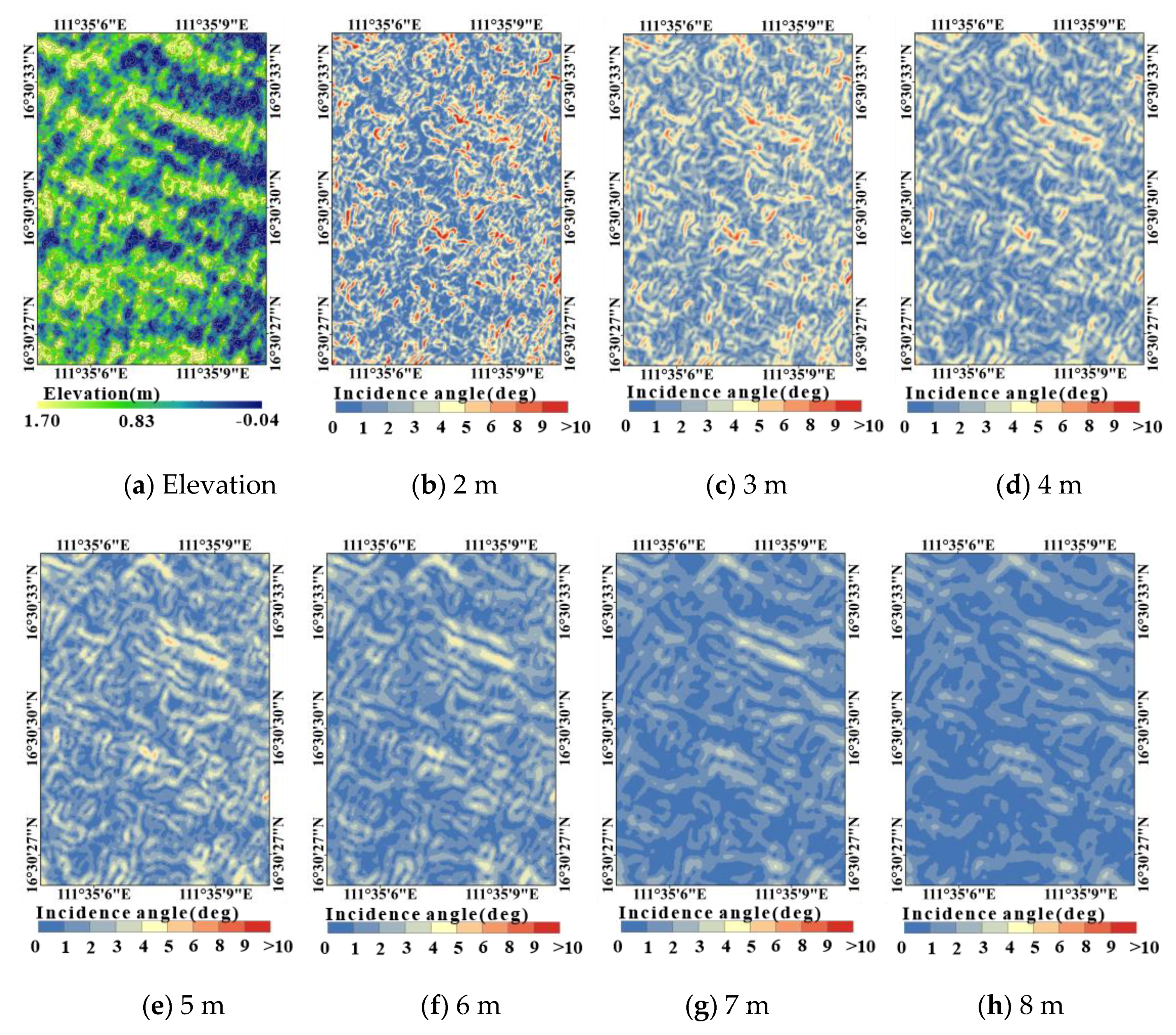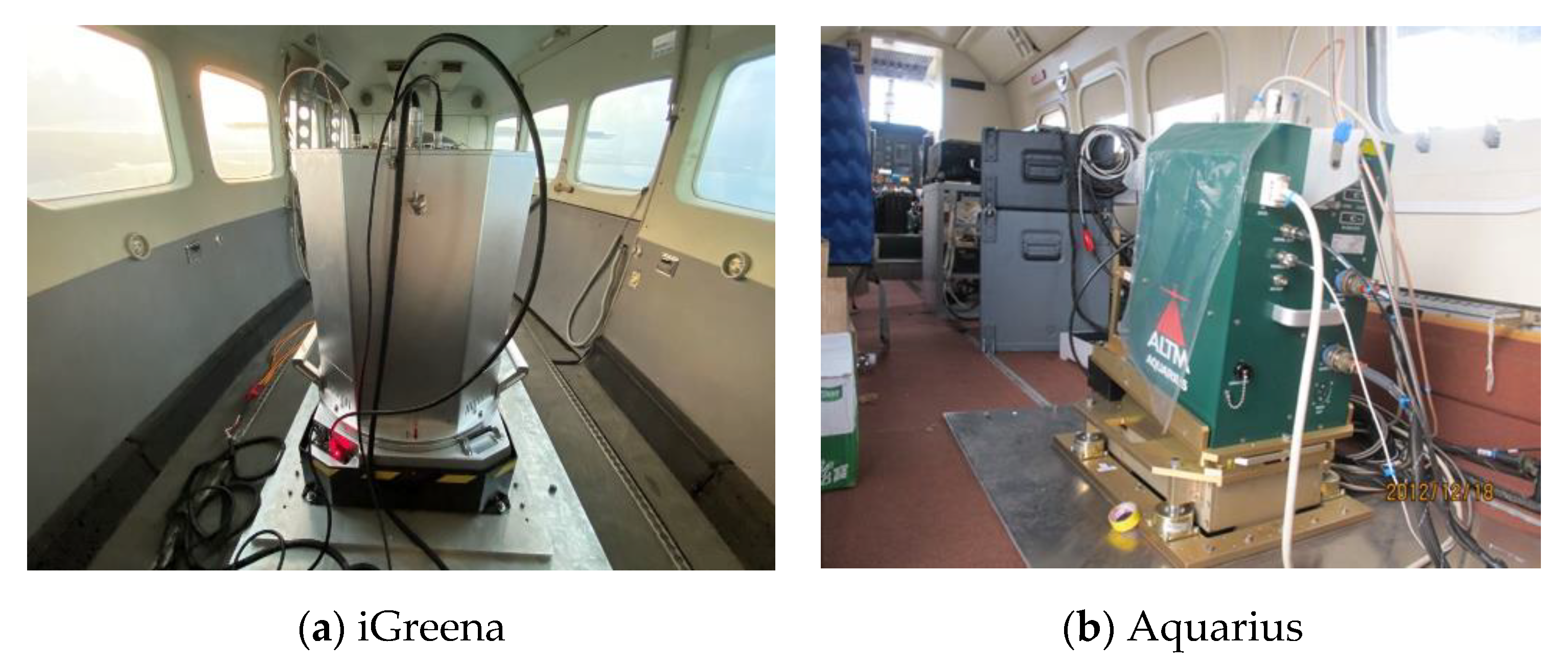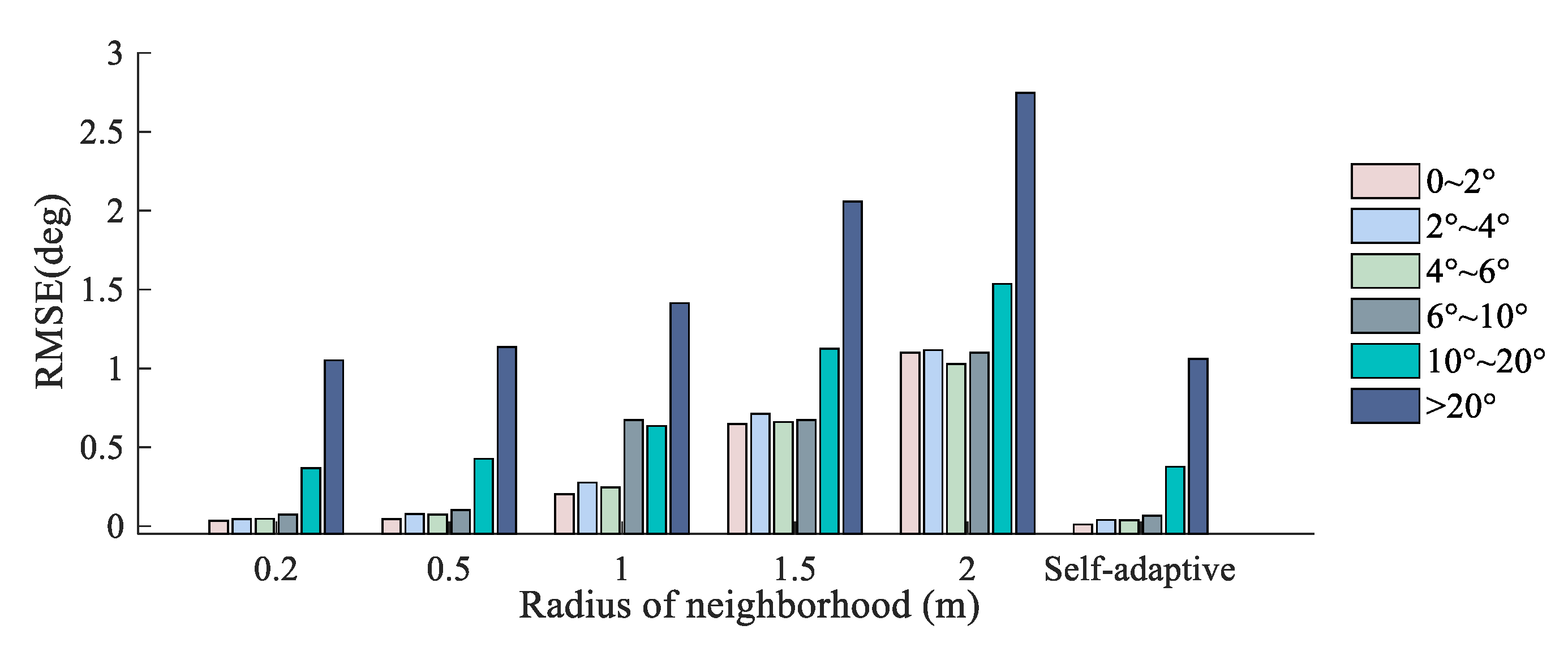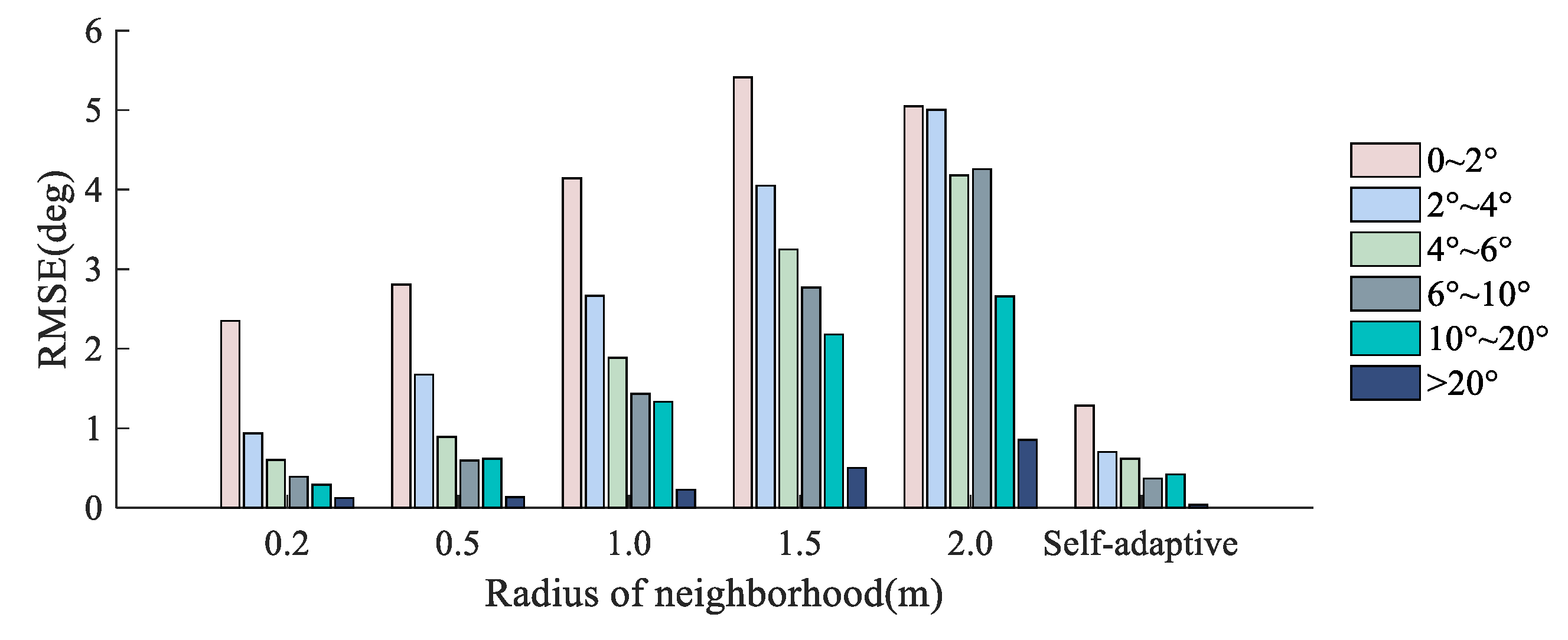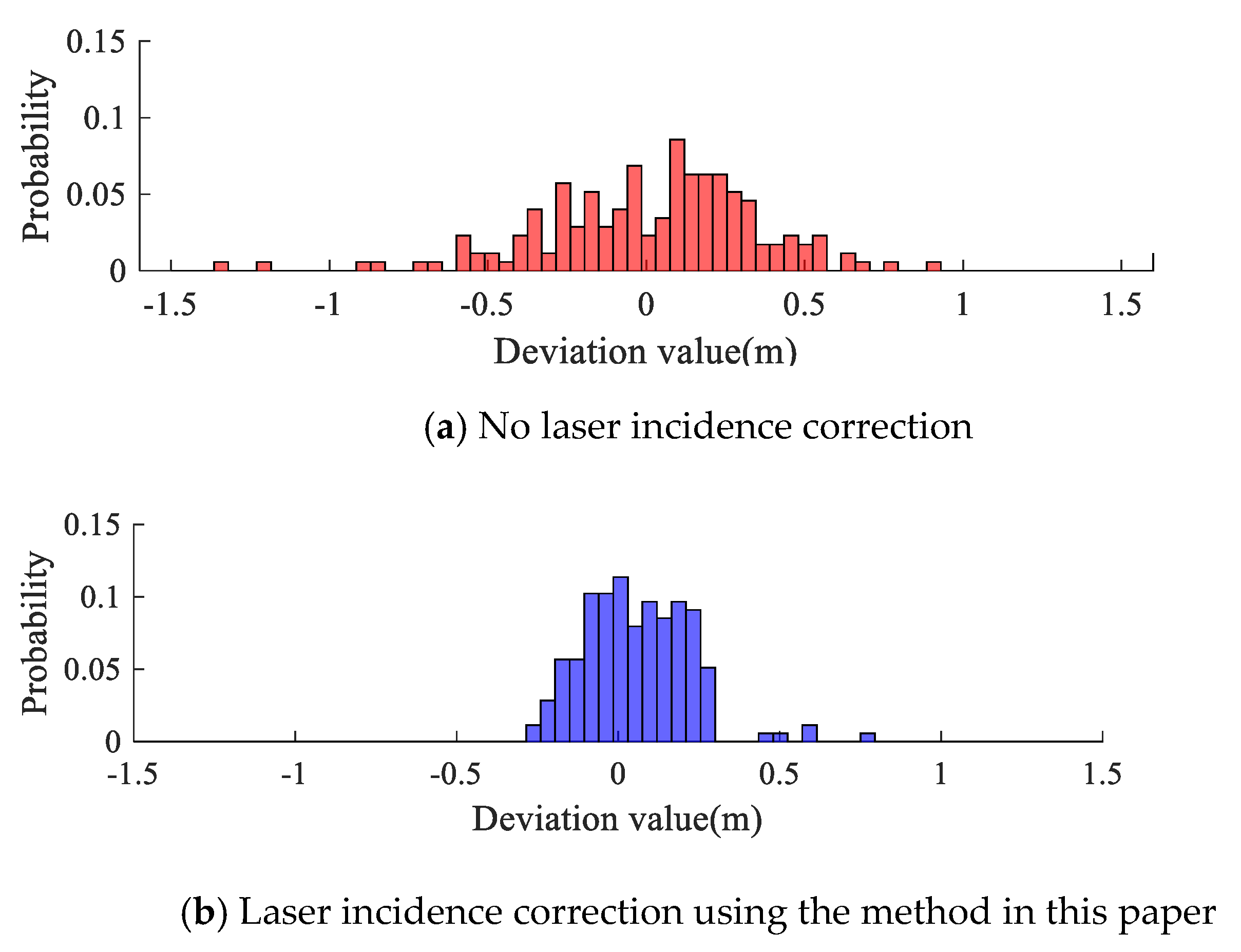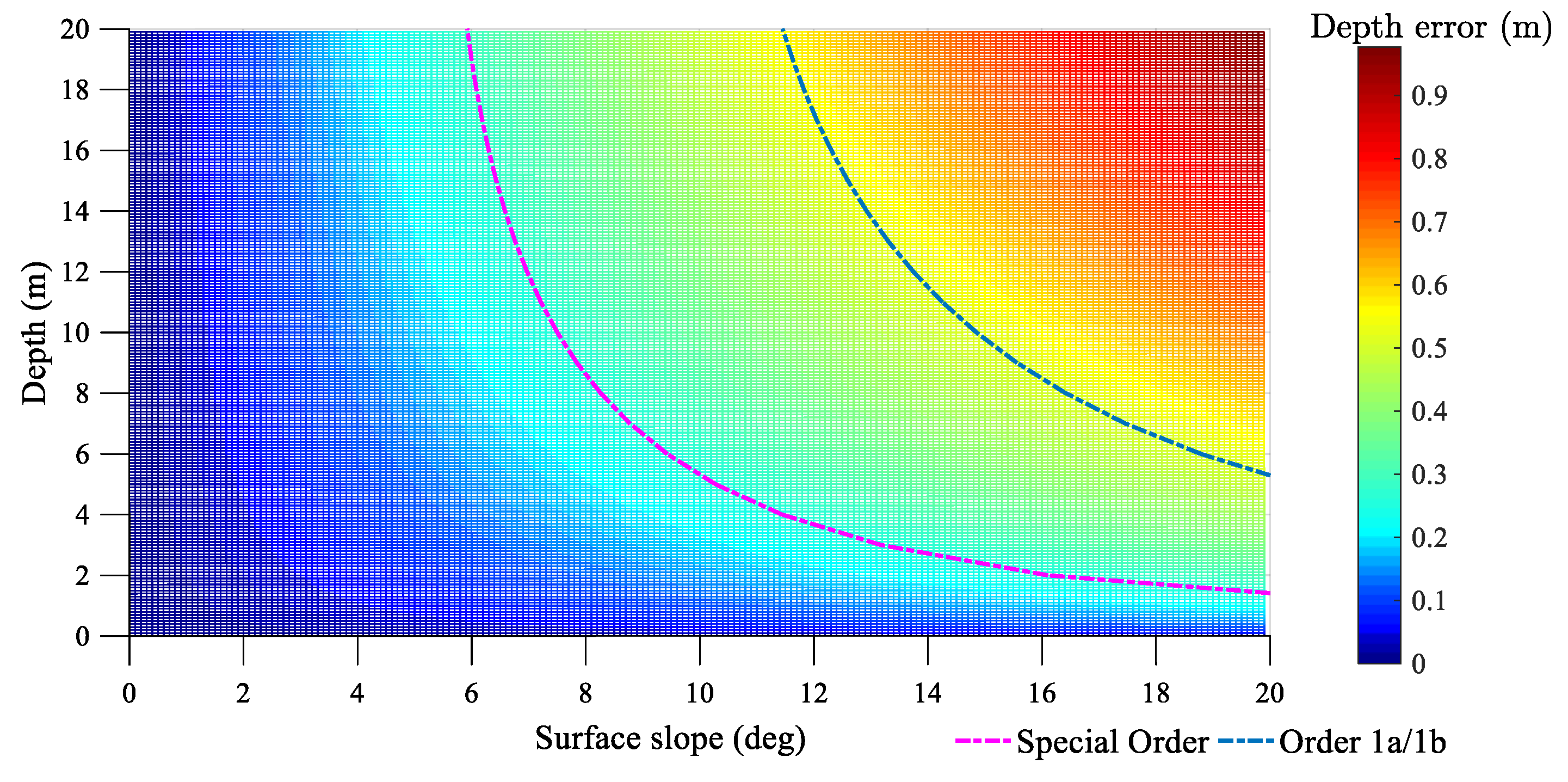4.1. Accuracy Comparison for Surface Normal Vector Estimation
The ocean surface affected by wind waves and swells is usually complex and uncertain. The neighborhood point selection radius is directly related to whether the laser incidence correction method can reflect the features of the surface topography. The spatial direction of the laser incident normal vector can be decomposed into zenith and horizontal vectors (
Figure 4). Ideally, their values should be equal to the surface slope and aspect at the laser incident position. In this section, we obtain the statistics of the slope and aspect of each simulated surface by normal vector estimation and compare them with the calculated values of the corresponding position of the surface model to obtain the different accuracies of the normal vector estimation results obtained by different methods.
In actual processing, the observation results of the elevation gradient in the east and north directions can be considered to have the same accuracy when laser detection equipment with stable performance is used, and the more violent the surface undulation in a fixed area is, the greater the root mean square error (RMSE)
.
Equations (21) and (22) indicate that the main factors affecting the accuracy of the surface slope and aspect estimation are the detection accuracy of the local surface slope and elevation change at the spatial position.
In the following sections, the difference between the dimension-based self-adaptive neighborhood point selection method and the fixed neighborhood point selection method is compared intuitively and quantitatively. The relationship between the neighborhood size and the accuracy of normal vector estimation under different surface changes will be analyzed in detail.
- (1)
The effects of surface inclination and neighborhood point selection radius on normal vector estimation accuracy
To analyze the influence of the neighborhood point selection radius and the surface inclination on the accuracy of normal vector estimation, we selected the simulation surface S4 (
Figure 8d) as the research object, and the classification statistics of the results by different normal vector estimation radii and surface slope angles were calculated.
Figure 14 and
Figure 15 show the statistical results of the estimated error of the surface slopes and aspects, and
Table 5 and
Table 6 show the specific values.
From the overall trend of the error statistics in
Figure 14 and
Figure 15, the radius of neighborhood point selection has an obvious correlation with the correction accuracy. In the case of similar surface inclinations, the estimated deviation based on the point clouds is positively correlated with the radius of the neighborhood point selection, while the estimation accuracy of the laser incident deviation decreases with increasing neighborhood point radius. Actually, a larger inclination usually occurs in areas with violent elevation changes, and the estimation accuracy of the local laser incident surface is affected by the coupled effects of the surface elevation and inclination. Judging from the numerical values of the experimental results, when the local water surface inclinations are similar, the deviation in the aspect estimation is larger than the deviation in the slope estimation. Within the same normal vector estimation neighborhood radius, the slope estimation accuracy gradually decreases with increasing surface inclination, which means that the main factor that affects the slope estimation is the elevation gradient detection accuracy of the ALB system. Unlike the case of slope estimation, the key factor that affects the accuracy of local aspect estimation is the surface inclination.
- (2)
The effects of elevation undulations and neighborhood point selection radii on normal vector estimation accuracy
The RMSEs for the slopes and aspects obtained by different neighborhood selection schemes are shown in
Figure 15 and
Figure 16, and the specific values are in
Table 7 and
Table 8.
From
Figure 16 and
Figure 17, it can be seen that the simulated surface elevation fluctuations have a significant impact on the estimation accuracy of the local slope and aspect. Moreover, the correlation between the estimation accuracy and the radius of the neighborhood is consistent with the previous discussion. With the same neighborhood radius, the slope calculation accuracy in a flat point cloud surface is relatively high, while the calculation error of the local aspect gradually increases with the decrease in the elevation gradient.
In the above simulated surface experiments, the dimension-based neighbor point selection method suggested in this paper maintains good slope and aspect estimation accuracy under different elevation fluctuations. The experimental results reflect the following two features in the laser incident normal vector correction process:
- a.
Adaptability of the incidence angle correction method
According to the previous analysis, we can infer that the main factor affecting the slope estimation accuracy is the surface elevation complexity, and the surface inclination at the target position plays a significant role in the accuracy of surface aspect estimation.
In
Figure 14,
Figure 15,
Figure 16 and
Figure 17, the RMSE of the estimated slope and aspect deviation increases with increasing neighborhood selection radius under different changes in surface inclination and elevation. This is because when the neighborhood radius increases, more laser points participate in the calculation of normal vectors. If the laser point selection area exceeds the region of terrain features, then a smoothing effect is produced in the processing of normal vector estimation based on PCA.
The undulation characteristics reflected by the surface point cloud obtained by scanning have been limited by time and space. When the neighborhood radius used in the estimation of the incident normal vector is too large, it often results in distortion of the incidence correction effect. When the neighborhood is too small, the noise in the water surface point cloud can easily interfere with the correction result. Adopting a neighborhood selection strategy with an adaptive mechanism is beneficial to improve the applicability of the water surface incidence correction method to different systems and environmental conditions. Through the above experiments, it can be seen that the dimension-based neighborhood selection method can adjust the selection radius of the corresponding neighborhood based on the principle of information entropy, and the calculation process has good adaptability.
- b.
Stability of the correction effect under different sea conditions
In Equations (22) and (23),
is a monotonically decreasing function, and its value is less than 1. Compared with that of
in Equation (23), which is also a monotonically decreasing function, the descent speed of
is significantly lower. Therefore, the accuracy of slope aspect estimation results is more sensitive to slope changes. By analyzing the phenomena in
Figure 16 and
Figure 17 above, it can be seen that the influence of the surface elevation complexity on the accuracy of the surface slope estimation is greater than that of the slope value in a fixed area, but for the surface aspect, the degree of the surface inclination is the main factor affecting the accuracy. In addition, the wave undulations on the sea surface are complex and changeable. Different scanning methods and environmental conditions affect the density of the point cloud of the water surface. This should be the direct reason for the different effects of laser incidence correction methods. Since the method suggested in this paper can adaptively select the neighborhood radius through surface morphology characteristics, it maintains good normal vector estimation accuracy for different surface undulations, which is of great significance for the incidence correction stability under different surface fluctuations.
4.2. Correction Effect for ALB System Measured in the Areas
The uneven distribution of the water surface point cloud caused by the scanning mode of airborne LiDAR bathymetry and the dynamic water environment in the target area has a great impact on the estimation of the normal vector of the incident laser. To analyze the influence of the neighborhood point selection radius at the incident position for estimating the normal vector, different neighborhood radii were used to calculate the normal vector based on the actual measured surface point clouds in Experimental Area A and Experimental Area B.
- a.
Estimation of the slope of the wind wave surface
To evaluate the difference in the effect of the laser incident normal vector estimation with different neighborhood point selection radii on the actual wave surface, we calculated the correction angles of the laser incident normal vectors, which can be regarded as the surface slopes, in the different experimental areas and then used the Weibull function to fit the values of the correction angles in
Figure 12 and
Figure 13.
where
is the random variable,
is the scale parameter and
is the shape parameter. In the Weibull function, if the shape parameter is increasing, the peak value of the probability density function deviates from zero, while the larger the scale parameter is, the wider the probability density function. The trends of the scale and shape parameters of the results obtained from the processing of each neighborhood radius are shown in
Figure 18 and
Table 9.
In
Figure 18 and
Table 9, there is no obvious correlation between the values of the scale parameter and the neighborhood radius, and the change in the scale parameter magnitude is small. This indicates that the dispersion of the water surface slope does not change much for different radii. In addition, the shape parameter decreases with increasing radius, which indicates that the maximum probability of sea surface inclination gradually approaches zero; that is, as the local normal vector estimated neighborhood radius increases, the laser incidence angle compensation value decreases. This is because a larger radius causes local undulation characteristics to be ignored in the process of the incidence normal vector calculation, so the water surface state described by the normal vectors tends to be smooth. Since laser incidence normal vector estimation using a smaller neighborhood radius is generally susceptible to abrupt local changes and surface signal noise interference, the undulating characteristics of the water surface cannot be accurately reflected in general. This result is consistent with the correspondence between the estimated water surface slope and the maximum probability density.
Local ocean surface wind waves always have a certain randomness. Let the surface inclination be
, and
is the surface wind speed. The probability density
of the ocean surface inclination can be calculated according to the Cox–Munk model. The model is as follows:
where the inclination angle corresponding to the maximum probability density is
, and its value reflects the overall features of the sea surface undulation state under the current wind speed conditions.
We analyze the consistency of the local undulating water surface inclination and the incidence correction results in the following. The surface inclination angles can be estimated from wind speed reanalysis data, and the Cox–Munk model and the local laser incident angles can be calculated from the surface laser point clouds obtained by different ALB systems in the two experimental areas. Since Experimental Area A is only 3 km away from the mainland of Hainan Island, considering that the low-altitude wind speed in this area is obviously affected by the land of Hainan Island, we choose the wind speed reanalysis data of ERA5-Land of the European Centre for Medium-Range Weather Forecasts (ECMWF) as a reference (
https://cds.climate.copernicus.eu/cdsapp#!/dataset/reanalysis-era5-land?tab=form, accessed data: 13 August 2020). The time resolution of the ERA5-Land reanalysis data is 1 hour, the spatial resolution is 0.1° in latitude and longitude and its numerical results take into account the interaction of wind speeds on the underlying surface, which has good applicability in land and coastal areas. Experimental Area B lacks reanalysis data with underlying surface analysis. Therefore, we use National Centers for Environmental Prediction (NCEP) wind speed data as a reference for comparison (
ftp://ftp.cdc.noaa.gov/Datasets/ncep.reanalysis/surface_gauss, accessed data: 13 August 2020). The time resolution of NCEP reanalysis data is 1 hour, and the spatial resolution is 0.25° in latitude and longitude.
Table 10 shows the sea surface wind speed data of the two experimental areas, where u10 is the northward component of the 10 m wind, v10 is the eastward component of the 10 m wind and GMT is Greenwich Mean Time.
During the experimental period, the wind speed at 10 m above the water surface was approximately 4.11 m/s, and the wind speed above Ganquan Island was approximately 9.94 m/s. However, because Experimental Area B is in the semi-enclosed area formed by coral reefs in the Xisha Yongle Atoll area, the water surface has a small degree of wave undulation. The deviation between the sea surface inclination corresponding to the largest probability density calculated by the Cox–Munk model and the correction value of the laser incident angle obtained by using different neighborhood radii can be calculated as follows:
Based on the above equation, the variations in the deviation between
obtained from the wind speed data during the experimental period and
in
Table 10 are shown in
Figure 19.
Figure 19 shows the surface undulations under different neighborhood selection conditions. Compared with Experimental Area A, Experimental Area B is a part of the Yongle Atolls in the South China Sea, and the actual wind and waves on the surface of the atoll are limited by the water depth and seafloor topography. Therefore, although the deviation of Experimental Area B is larger than that of Experimental Area A, the trends of the surface undulation estimation results of the two experimental areas are similar. In
Figure 18 and
Figure 19, as the neighborhood is too small, the stability of the laser incident normal vector estimation effect is poor. This phenomenon may be caused by the interference of water surface undulations and local point cloud noise. When the neighborhood is too large, the slope estimation result from surface point clouds is more distinct from that of the Cox–Munk model. The self-adaptive neighborhood selection method based on the spatial distribution of point clouds and the principle of information entropy effectively avoids the difference caused by different neighborhood selection ranges in the normal vector calculation process. The result processed by this self-adaptive method shows that it can maintain local undulation details and restrain the abrupt change in water surface elevation to some extent.
- b.
The improvement of laser incident correction on bathymetry accuracy
To evaluate the ALB detection accuracy, we simultaneously carried out single-beam water depth detection experiments. The spatial distribution of single-beam depth points in the experimental areas is shown in
Figure 20.
The vertical deviation between the synchronously observed single-beam depth points and the mesh established by the laser point cloud on the seafloor can be used to evaluate the water depth detection effect after the undulation surface incidence correction. Based on this, we analyzed the improvement of the laser detection results at specific locations.
In
Figure 20, the distribution of the depth points evenly covers the ranges of the experimental areas, although the sampling frequency of the single-beam depth points in Experimental Area A is relatively low. The histograms of the deviation between the mesh of the seafloor laser point cloud and the single-beam depth points are shown in
Figure 21.
Figure 21 shows that the discrete state of the deviation values in the initial data has been improved, and most deviation values are concentrated near the value of zero, which means that the deviation between the point cloud and the single beam after the sea surface wave correction is significantly reduced.
The single-beam bathymetrical points in Experimental Area B evenly cover the experimental area according to the designed route, and more depth points are obtained by improving the sampling frequency.
The statistical result of Experimental Area B in
Figure 22 also shows a similar characteristic to that of Experimental Area A after laser surface incident correction.
Table 3 contains the average and the RMSE of deviations between the correction result and the single-beam depth point in the two experimental areas. In Equations (27) and (28),
is the depth value of a single beam on the seafloor, and
is the depth value of the seafloor mesh obtained by ALB at the corresponding position.
is the number of the single-beam depth points.
is the average of the deviation value, and
is the RMSE.
From the statistics of the deviation in
Table 11, the sea surface wave correction based on the dimension-based self-adaptive local normal vector calculation can shift the results obtained by the ALB system closer to the true water depths, where the reduction is the absolute value of the change before and after the incident correction. After laser incidence correction, the depth detection results in the experimental area met the accuracy requirements of International Hydrographic Organization Special Order (IHO S-44) [
43]. According to the experimental analysis, this model is an effective sea surface wave correction model that can effectively solve the uncertainty caused by sea surface undulations in the airborne laser detection process.
Previous studies on laser incident correction methods for small-footprint ALB systems mainly referred to local curved surface modeling to reconstruct the laser propagation process. Complex modeling based on scanning point clouds for instantaneous fluctuating water surfaces is the focal point for such methods [
44,
45]. In [
12], the water and land integration point cloud around Wuzhizhou collected by the Aquarius system has the same sediment as and similar environmental conditions to Experimental Area A in this article. Yang et al. used the wave spectrum model to fit the air–water interface and reduced the error from laser refraction, and the RMSE decreased by 9.2 cm. However, the wave surface simulation method aims to reconstruct the laser incident surface by building the wave spectrum model, which relies on the ALB system scan status and ocean environment-related parameter presets. Therefore, the correction effect is obvious, but the process is more complicated.
The method proposed in this paper can estimate the laser incident direction in a self-adaptive way, and the correction accuracy of the water depth detection results is good and relatively stable, especially under the conditions of complex ocean surface undulations and uneven points. In addition, self-adaptive processing based on the principles of information entropy and local interface feature dimensions does not require a complicated sea surface simulation, which is beneficial in fast processing.
4.3. The Influence of Undulating Water on ALB Depth Detection
In addition to the signal reception and data processing accuracy of the system itself, the factors directly affecting the water depth detection capability of the ALB system also include the zenith angle of the scanning laser beam, the refractive index of the propagation medium and the water depth conditions of the target area. The dimension-based self-adaptive method of laser incidence correction can reduce the negative influence of ocean surface waves on ALB system bathymetric detection. If we regard the influence of the undulating water surface on the incident angle as a kind of incident angle error, the depth deviation caused by the change in the incident direction can be analyzed according to the law of error propagation.
in Equation (29) is the instantaneous depth obtained by the ALB system after signal processing.
The water depth obtained by the ALB system is mainly related to the altitude of the airborne platform , the laser emission angle , the relative refractive index between the air and water and the propagation distance of the laser in the air and water, and , respectively. is detected by the position and orientation system (POS), and the accuracy of and of each laser beam mainly depends on the echo signal processing capability. In addition, because the change in the optical refractive index is relatively small in shallow and uniform water, the influence on the laser underwater detection result itself is smaller than that from the other factors proposed above, and its influence will not be analyzed in much detail here.
If only the environmental impact of the detection area is considered, the change in the angle of incidence caused by the real-time changes in water surface waves should be regarded as an important environmental factor that causes the system’s bathymetric deviation. In the above equation, according to the law of error propagation, the water depth detection accuracy model of the beam incidence deviation caused by surface undulation can be calculated.
where
is the deviation of the laser incident angle caused by the undulation of the water surface, which is equal to the slope angle of the local surface, and
is the refraction angle of the laser beam after passing through the water surface. The specific value can be calculated according to Equation (30). This reflects the relationship between the system’s underwater terrain detection accuracy and the laser incident angle. Based on this, we calculated the depth deviation of the ALB system with different incident angles and water depth conditions.
Figure 23 indicates that the deeper the target ocean area is, the more susceptible the ALB system is to surface undulations. When considering only the impact of surface waves, the bathymetric accuracy of the ALB system also has significant differences in the responses to different emission angles and ocean surface slopes. In recent years, commercial ALB systems have mainly used the circular scanning method with a single emission angle, and the laser emission angle is in the range of 15–20°. As the linear scanning method constantly changes the emission angles during scanning processing, the circular scanning method has more advantages in the overall accuracy and stability of the depth estimation deviation.
As the water depth of the target water area is less than 20 m,
Figure 24 shows the depth deviation when the laser emission angle of the ALB system is 20°. The curves in the figure represent the minimum accuracy requirements of the IHO S-44 Special Order and Order 1a/1b.
Table 12 shows the minimum bathymetry standards for the safety of navigation hydrographic surveys and the corresponding allowable sea surface slope without incident angle correction in different depth ranges for the ALB system bathymetric results. TVU is a quantity with all contributing vertical measurement uncertainties included, and
is the maximum allowable surface slope.
As in the above analysis, first, choosing a stable water surface environment is generally beneficial for ALB water surface incidence correction. In addition, waves will adversely affect the applicability of the ALB system’s depth measurement results. As shown in
Table 12, when the surface slope is greater than 5.85° and 11.57°, the bathymetric error with a depth of more than 10 m may exceed the accuracy requirements proposed by the IHO S-44 Special Order and Order 1a/1b, respectively. In other words, if the bathymetric error is larger than the corresponding order standards, the water surface waves will cause obvious interference to the ALB system’s bathymetric accuracy; in that case, the adjustment of the ALB system’s sounding results by the laser incidence correction model is necessary.

